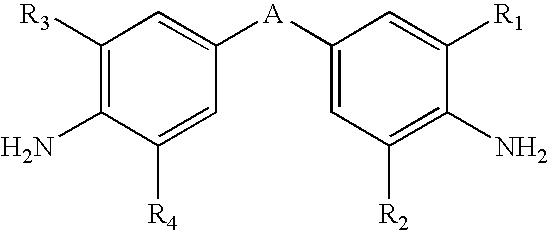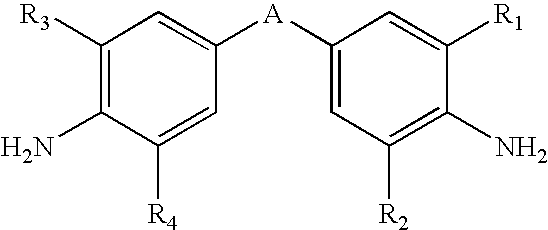Polyimide film-laminated body
a polyimide film and laminated body technology, applied in the field of laminated bodies, can solve the problems of low peel strength, low peel strength of laminated bodies formed by metal vapor deposition or sputtering, and inability to achieve high adhesive strength with adhesives, etc., to achieve improved moisture permeation rate, improved surface adhesion, and high adhesive strength
- Summary
- Abstract
- Description
- Claims
- Application Information
AI Technical Summary
Benefits of technology
Problems solved by technology
Method used
Image
Examples
examples 1-5
[0075]Solution 1 and solutions 2-6 were combined in a proportion such that the molar ratio of PPD as the diamine in the first solution and the diamine in the second solution was 90:10, and 1,2-dimethylimidazole was added to 2 mass % with respect to the polyamic acid. The resulting solution was coated onto the rough surface of a copper foil (SLP by Nippon Denkai, Ltd., 18 μm thickness) to a final film thickness of about 25 μm and heated at 135° C. for 3 minutes to form a solid film, after which it was anchored to a stainless steel frame and heated at 130° C. for 3 minutes and at 180° C. for 1 minute, raised in temperature to 450° C. over a period of 5 minutes and held at 450° C. for 2 minutes for heat treatment to obtain a polyimide copper foil laminated body. No foaming or delamination was observed in the obtained laminated body.
[0076]The 180° peel strength at the interface of the laminated body was measured to evaluate the adhesive strength. The copper foil of the laminated body wa...
examples 6-9
[0084]A polyimide copper foil laminated body was obtained in the same manner as Example 1, except that solution 1 and solution 3 were combined so that the diamine content in solution 3 was as listed in Table 2,1,2-dimethylimidazole was further added at 2 mass % with respect to the polyamic acid, and the resulting solution was coated onto the rough surface of a copper foil (SLP by Nippon Denkai, Ltd., 18 μm thickness) to a final film thickness of 25 μm. No foaming or delamination was observed in the obtained laminated body.
[0085]The 180° peel strength at the interface of the laminated body was measured to evaluate the adhesive strength. The copper foil of the laminated body was then etched with a 40% ferric chloride aqueous solution and the elastic modulus and breaking strength of the obtained polyimide film were measured.
[0086]The results are shown in Table 2.
example 10
[0089]A polyimide copper foil laminated body was obtained in the same manner as Example 2, except that coating was to a final film thickness of 15 μm. No foaming or delamination was observed in the obtained laminated body.
[0090]The results are shown in Table 2.
TABLE 2DiaminePolyimideTen-content oflayerBreak-sile180°Foam-polyimidethick-ingmodu-Peeling / layernessstrengthlusstrengthdelam-Example(mol %)(μ)(MPa)(GPa)(kg / cm)inationExampleSolution 3254307.90.6none65%ExampleSolution 3253707.41.15none715%ExampleSolution 3253407.21.2none820%ExampleSolution 3253306.81.2none930%ExampleSolution 3154107.81.1none1010%Compara-Solution 3251134.4nonetive50%Example3
PUM
| Property | Measurement | Unit |
|---|---|---|
| Thickness | aaaaa | aaaaa |
| Elastic modulus | aaaaa | aaaaa |
| Elastic modulus | aaaaa | aaaaa |
Abstract
Description
Claims
Application Information
 Login to View More
Login to View More - R&D
- Intellectual Property
- Life Sciences
- Materials
- Tech Scout
- Unparalleled Data Quality
- Higher Quality Content
- 60% Fewer Hallucinations
Browse by: Latest US Patents, China's latest patents, Technical Efficacy Thesaurus, Application Domain, Technology Topic, Popular Technical Reports.
© 2025 PatSnap. All rights reserved.Legal|Privacy policy|Modern Slavery Act Transparency Statement|Sitemap|About US| Contact US: help@patsnap.com


